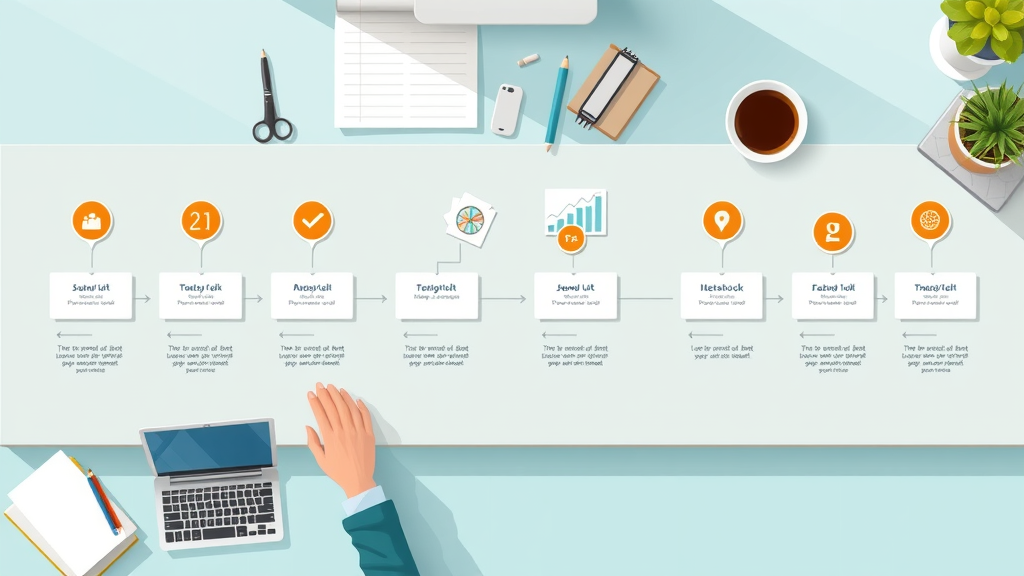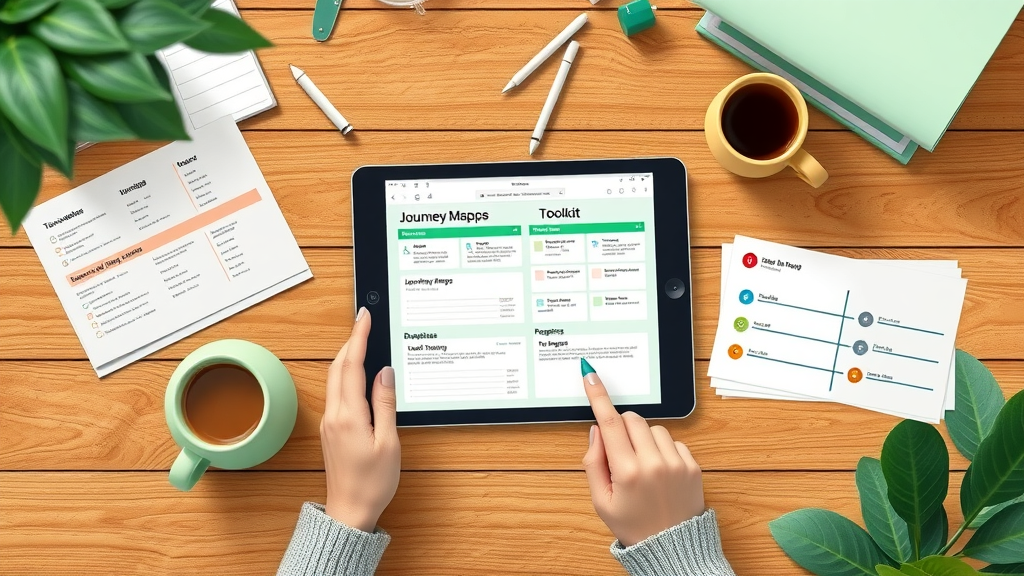Did you know that 87% of leading organizations report customer journey mapping boosts their customer satisfaction —and that mastering this process can directly increase sales by 18% or more? In today’s competitive landscape, mapping out how your customers interact with your brand isn’t just a nice-to-have; it’s a pivotal tool for growth and lasting loyalty. This comprehensive guide dives into every aspect of customer journey mapping —demystifying the process, highlighting its powerful impact on sales and retention, and equipping you with actionable examples to unlock the next level of your business.
Whether you’re aiming to close more deals or perfect your customer service, understanding each phase of the customer journey is the key to anticipating needs, removing friction, and outpacing your competition. Let’s embark on this journey together and transform your approach—one expertly crafted journey map at a time.

Unveiling the Power of Customer Journey Mapping: Startling Insights & Business Impact
Discover why 87% of leading organizations say customer journey mapping directly improves customer satisfaction.
Learn how mastering journey maps can increase sales by 18% or more.
Surprising fact: Companies with strong customer experience strategies powered by journey mapping outperform competitors by two to three times in revenue growth.
Customer journey mapping isn’t just an industry buzzword—it’s the backbone of high-performing sales and customer experience strategies. Recent research confirms that organizations leveraging journey maps see measurable improvements in both customer satisfaction and bottom-line revenue. When you visualize customer journeys, you’re better equipped to identify pain points, streamline user experience, and create a seamless path to purchase. In fact, the process not only clarifies where prospects drop off, but also empowers teams to correct course in real-time, resulting in stronger retention and higher conversions.
Companies with a culture of journey mapping break down silos between marketing, sales, and customer service. This unified approach gives a full view of the entire customer experience , and it’s proven that businesses embracing this methodology double or even triple their revenue growth compared to competitors. The facts speak for themselves: customer journey mapping isn’t just about understanding the customer—it’s about unlocking your full revenue potential.

What You'll Gain from This Guide to Customer Journey Mapping
The fundamentals and importance of customer journey mapping
Practical applications of customer journey maps for sales growth
Step-by-step journey mapping processes with actionable examples
How to leverage journey maps to address pain points and improve customer experience
Expert insights, useful templates, and real-world case studies
This guide is designed for professionals, business owners, and marketers eager to reposition their brands for exceptional growth through customer journey mapping . You’ll find practical frameworks, step-by-step instructions, and downloadable resources to help you implement high-impact journey maps. By the end, you’ll be empowered with all the tools to identify your ideal customer persona, optimize customer touchpoints, and leverage actionable feedback for better retention—and more sales.
Understanding Customer Journey Mapping: Core Concepts and Definitions
What is Customer Journey Mapping?
Definitions of customer journey mapping and journey map
The role of customer journey maps in visualizing customer experience
Differentiating customer journey maps from service blueprint
Customer journey mapping is the process of visually outlining every interaction a customer has with your business, from first discovery to repeat purchases and advocacy. A journey map serves as a powerful visual representation, enabling you to understand the customer’s perspective throughout all touchpoints. Unlike a service blueprint , which focuses on behind-the-scenes operations and roles that support the customer experience, a journey map zeroes in on the customer’s own story, highlighting how customers interact with products, services, and channels at every stage.
By creating a customer journey map, you transform otherwise abstract experiences into clear, actionable diagrams. This makes complex customer behaviors and pain points visible—providing everyone in your organization with a shared reference point for improvement. It’s this clarity that leads to targeted optimizations and measurable growth in both customer satisfaction and sales outcomes. Embracing customer journey mapping drives alignment and empowers your team to deliver a seamless journey that resonates deeply with your target audience.
Why Customer Journey Mapping Matters for Modern Businesses
Impact of customer journey mapping on sales and customer satisfaction
Integrating customer feedback and customer service into your strategy
How journey mapping drives customer retention
For modern brands, understanding—and purposefully shaping—the customer experience is a major competitive advantage. Customer journey mapping not only illuminates each pain point along the journey, but it also integrates crucial feedback from customer surveys and post-purchase interactions. When businesses actively respond to customer feedback, they’re more likely to foster customer loyalty and dramatically reduce attrition. As a result, journey mapping becomes a linchpin for long-term customer retention , enabling you to continuously improve your processes and service delivery.
Integrating insights from journey maps into your customer service strategy is especially impactful. By proactively solving recurring issues and closing harmful experience gaps, you not only improve satisfaction metrics but also drive repeat sales and brand advocacy. With the right approach, the journey mapping process helps transform passive buyers into engaged customers and ultimately, enthusiastic brand promoters.
“Every interaction, whether digital or in-person, shapes your customers’ perceptions—understanding their journey is key to unlocking loyalty and sales.”
Comparison of Customer Journey Maps, Journey Maps, and Service Blueprints |
|||
Feature |
Customer Journey Map |
Journey Map |
Service Blueprint |
|---|---|---|---|
Primary Focus |
Customer’s experience across all touchpoints |
Specific process, persona, or goal |
Frontstage (customer-facing) & backstage (behind-the-scenes) processes |
Visualization |
Visual timeline of customer actions/emotions |
Step-by-step journey for a persona or use case |
Integrated workflow with staff roles and tech systems |
Best For |
Identifying pain points, optimizing experience |
Focusing on major interactions or single journeys |
Improving internal processes supporting CX |
Typical Example |
Online purchase from awareness to advocate |
Product onboarding journey |
Restaurant service from order to delivery |
The Anatomy of an Effective Customer Journey Map
Essential Elements of a Customer Journey Map

Customer persona and target customer base inclusion
Identification of customer touchpoints and pain points
Mapping the phases of the customer journey
A high-impact customer journey map starts with a deep understanding of your ideal customer persona and customer base . These personas represent your typical users, including their demographics, needs, motivations, and expectations. By centering your journey map on core personas, you ensure every decision and improvement specifically addresses your highest-value audience—driving stronger engagement and sales results.
Next, comprehensive journey maps detail customer touchpoints —the connection points between your brand and customers. This includes everything from digital ads to social media, website visits, in-store interactions, and customer service calls. Mapping these touchpoints, as well as potential pain points or friction, is essential to seeing the full picture. Phased mapping clarifies each distinct stage of the customer journey, such as awareness, consideration, purchase, loyalty, and advocacy, making it easier to craft targeted improvements at every level.
Types of Journey Maps: Choosing the Right Map Template
Benefits of using journey map templates
Different map template formats with examples
Selecting the right journey map template streamlines your entire customer journey mapping process. Templates help standardize information, allowing teams to quickly visualize and interpret patterns across different personas and product lines. Examples include simple chronological timelines, grid-based emotion-versus-action matrices, and service blueprint hybrids. Each format has unique strengths: timelines are perfect for visualizing progression, matrices excel at capturing emotional highs and lows, and blueprint-style templates demystify backend interactions that impact the visible experience.
Customizable templates guarantee every journey map is actionable—giving you an adaptable framework for continuous optimization as your product or audience evolves. Leveraging map templates saves time and enables stakeholders to focus on interpreting insights and making improvements, not on formatting data. Use downloadable templates to jumpstart your mapping efforts, and remember to tailor your choice to the specific needs of your business and customers.
Visualizing Customer Journeys for Greater Impact
Incorporating images and diagrams in journey mapping
Case studies: High-impact customer journey maps in action
Effective visualization transforms customer journeys from abstract concepts into compelling, easily digestible narratives. By integrating infographics, flow diagrams, and customer sentiment charts, you provide clarity for stakeholders and ensure everyone aligns on where to focus efforts. Visual journey maps can uncover trends—such as frequent pain points or critical points of delight—that are otherwise easy to miss. Blending visuals with qualitative feedback (like quotes from customer survey responses) deepens understanding and makes the case for specific optimizations even stronger.
Consider successful brands like Amazon and Zappos that routinely update and share journey maps to inspire improvements across all departments. Their best-in-class customer experiences are the result of a commitment to visual mapping, regular communication, and action—turning insights into concrete sales and retention results for years on end.

Mapping the Customer Journey: A Step-by-Step Guide
1. Define Your Customer Persona
How to identify and segment your customer base
Using customer survey and customer feedback for persona accuracy

Start your journey mapping process by crafting detailed customer personas . Analyze your customer base through market research, customer surveys , interviews, and sales analytics to identify key segments. Each persona should highlight unique behaviors, needs, and motivations, ensuring the journey map targets the people who drive best results for your business. Continuously validate personas with updated customer feedback and behavioral data so your mapping remains relevant and impactful over time.
2. Outline Customer Touchpoints and Channels
Comprehensive list of physical, digital, and emotional customer touchpoints
Importance of omnichannel journey mapping
Next, list every possible customer touchpoint , across both digital (website, email, social media) and physical (stores, events, phone support) channels. Don’t overlook emotional touchpoints—moments where your customers might feel excitement, confusion, or relief. A complete list reveals the many ways customers interact with your business, helping you pinpoint points of friction or missed opportunities. Omnichannel mapping is essential in today’s environment; your map should illuminate how customers move seamlessly (or not) between channels, ensuring consistent experiences wherever they engage.
By developing a holistic view of these channels, you’re better equipped to design experiences that resonate—building brand trust, lowering barriers to purchase, and boosting loyalty. It also enables your sales and marketing teams to develop messaging and offers tailored to each stage and channel in the journey.
3. Identify Customer Pain Points and Motivations
Techniques to surface and address pain points
Leveraging customer sentiment to refine the journey

Pinpointing pain points —the friction, obstacles, or frustrations preventing customers from progressing along their journey—is the heart of journey mapping. Gather data from support inquiries, social media complaints, and customer feedback to connect recurring issues with specific touchpoints. Categorize pain points by impact and frequency, then address them with targeted solutions. Don’t forget to map motivations as well—understanding why customers choose your product or brand can help you build on positive experiences as you resolve negative ones.
Regularly updating your map based on new customer sentiment ensures consistent improvement. Use these insights to prioritize product features, website enhancements, or service upgrades—turning complaints into opportunities for delight and long-lasting loyalty.
4. Develop and Utilize a Journey Map Template
Step-by-step walkthrough of completing a journey map template
Downloadable template resources
Once you’ve gathered your data, plug your insights into a journey map template . Start by listing each persona and progressively chart their actions, thoughts, emotions, and touchpoints across the customer journey phases. Many digital tools offer ready-to-use templates, allowing for seamless updates and easy sharing across teams. Fill in each stage with supporting data and real customer quotes to enrich understanding.
Downloadable journey map templates not only accelerate the process of mapping but also encourage team-wide adoption and collaboration. Over time, update your maps with ongoing customer feedback and analytics insights to ensure your strategies remain aligned with evolving behaviors and expectations.
5. Analyze Discoveries and Optimize Customer Experience
Turning map data into actionable improvements
Real-world examples of journey mapping driving results

With your journey map completed, it’s time to put insights into practice. Analyze gaps between expectation and reality, track where customers drop off, and highlight positive experiences you can amplify elsewhere. Collaborate with cross-functional teams—sales, marketing, customer service—to design solutions for the most urgent pain points and maximize moments of delight.
Real-world brands showcase what’s possible: after implementing journey map findings, some businesses report a 15–25% increase in conversions, while others see drops in support tickets or improved Net Promoter Scores. The secret is continuous optimization: keep iterating on your map and measuring results for ongoing growth.
Leveraging Customer Journey Mapping for Increased Sales and Retention
Aligning Sales Strategies with the Customer Journey
How journey maps inform every phase of the sales funnel
Closing gaps between marketing, sales, and customer service

Customer journey maps are a vital sales tool. Using these maps, sales teams can craft messaging and engagement tailored to each phase of the sales funnel—from nurturing leads at the awareness stage, to addressing objections during consideration, and reinforcing value during post-purchase. By working closely with marketing and customer service , sales leaders align strategies, ensuring a unified narrative that guides the customer from first interaction to lifelong loyalty.
Eliminating gaps between departments makes for a smoother, more consistent experience. Successful organizations hold regular journey mapping workshops to analyze and coordinate touchpoints, ensuring that pain points are addressed not just in theory, but in everyday practice. When everyone is on the same page, customers notice—and sales results speak for themselves.
Upselling and Cross-Selling Through Customer Experience Insights
Using journey maps to identify upsell and cross-sell opportunities
Integrating customer feedback into product development cycles
Once pain points are addressed, journey maps can uncover natural moments for upselling and cross-selling—offering premium products or complementary services at just the right stage in the journey. For example, data may reveal that post-purchase follow-ups or onboarding check-ins are optimal moments to introduce upgrades based on customer interests and previous feedback. This approach isn’t just good for sales; it also enhances customer satisfaction by connecting customers with solutions they genuinely value.
Integrating continuous customer feedback into your product development cycles ensures that what you offer matches real customer needs. Journey mapping makes it easy to track where additional value can be delivered, enriching your offerings and driving long-term revenue.
“Customer retention isn’t a tactic—it’s a natural result of anticipating and solving pain points throughout the journey.”
Sales Impact Metrics Before and After Implementing Customer Journey Mapping |
||
Metric |
Before Journey Mapping |
After Journey Mapping |
|---|---|---|
Conversion Rate |
10% |
14% |
Customer Retention |
68% |
80% |
Customer Lifetime Value |
$1,250 |
$1,800 |
People Also Ask
What are the 7 steps to map the customer journey?
Answer:
Set clear objectives for journey mapping.
Develop customer personas.
Map all customer touchpoints.
Gather quantitative and qualitative customer feedback.
Identify pain points and customer emotions.
Visualize the entire customer journey with a journey map template.
Analyze, optimize, and iterate the customer journey based on insights.

What is meant by customer journey mapping?
Answer:
Customer journey mapping is the process of creating a detailed visual representation of every interaction a customer has with a brand, from discovery through post-purchase, to better understand and optimize the customer experience.
What are the 5 main points of a customer journey?
Answer:
Awareness
Consideration
Purchase
Loyalty
Advocacy
How do you map your customer journey?
Answer:
To map your customer journey, start by compiling data on your customers’ interactions, define your personas, outline all touchpoints, document pain points, and use a journey map template to visualize the process. Regularly update the map based on customer feedback and changing behaviors.
Best Practices, Common Mistakes, and Proven Tips for Effective Customer Journey Mapping
Avoiding Common Journey Mapping Pitfalls
Overcomplicating the journey map
Neglecting post-purchase experience
Ignoring cross-functional collaboration
When creating a customer journey map, it’s easy to get bogged down in endless data and lose focus. Overcomplicating the map reduces clarity and limits practical use. Similarly, failing to map the post-purchase experience overlooks crucial moments for loyalty-building and upselling. Finally, journey mapping works best when it involves cross-functional teams—from sales and marketing to customer service. Silos create blind spots, while collaboration fosters shared accountability and the richest possible insights.
Expert Tips for Lasting Customer Experience Improvements
Involve stakeholders from sales, marketing, and customer service
Update journey maps regularly using customer feedback
Employ service blueprint and analytics for deeper insights

The businesses that see the greatest results from journey mapping follow a few expert guidelines: actively involve team members from all relevant departments so no insights are missed; schedule regular map reviews updating inputs based on fresh customer feedback and behavioral analytics; and supplement journey maps with service blueprints for a full view of operations. This multi-layered approach guarantees you not only empathize with customers, but efficiently resolve pain points and exceed expectations.
Resources: Customer Journey Map Templates, Tools, and Further Reading
Downloadable journey map template options
Recommended software for digital journey mapping
Additional publications on customer experience and journey mapping

Ready to start? Download our curated library of journey map templates or leverage digital tools such as Miro, Smaply, or Lucidchart to rapidly build, update, and share maps with your team. Explore recommended reading—books, blogs, and research—to keep your skills sharp and your strategies ahead of the curve.
“The most successful businesses design customer journeys with intention, insight, and iteration.”
FAQs
How often should customer journey maps be updated?
Customer journey maps should be updated at least twice a year, or whenever significant changes occur in your products, services, or customer behaviors. Regular reviews ensure your maps reflect current pain points and opportunities, keeping your strategies relevant.
What are the best online tools for journey mapping?
Popular digital tools for journey mapping include Miro, Smaply, Lucidchart, and UXPressia. These platforms offer robust templates and collaboration features to streamline the mapping process for teams of any size.
Can customer journey mapping benefit B2B companies?
Absolutely. B2B companies, often facing complex and lengthy sales cycles, gain significant value from journey mapping by clarifying buyer needs, identifying critical touchpoints, and improving cross-departmental alignment for better deal close rates and retention.
How does journey mapping aid customer service teams?
Journey mapping empowers customer service teams to anticipate common pain points, proactively resolve issues, and deliver consistent, high-quality support at every phase of the customer journey, ultimately improving satisfaction and loyalty.
Maximizing the Value of Customer Journey Mapping: Critical Takeaways
Customer journey mapping transforms raw data into actionable sales strategies.
Addressing customer pain points is vital for improving retention and loyalty.
Combine journey maps with quantitative feedback for continuous improvement.
Ongoing optimization is key—don’t set and forget your journey maps.
Accelerate Your Business Growth with Next-Level Customer Journey Mapping
Ready to elevate your sales and customer experience? Apply these customer journey mapping techniques and leverage our recommended map templates today to unlock your next phase of growth.
To deepen your understanding of customer journey mapping and its impact on sales and customer satisfaction, consider exploring the following resources:
Struggling to make All of your marketing strategies work together seamlessly and effortlessly? Click the Link and Get our Ultimate Guide for Building a Content Marketing Strategy for Small Business..
“Customer Journey Map: Everything You Need To Know” ( forbes.com )
This article provides a comprehensive overview of customer journey maps, detailing their components, benefits, and how they can enhance customer satisfaction and business decision-making.
“Customer journey mapping 101 (+ free templates)” ( zapier.com )
This guide offers practical steps for creating customer journey maps, complete with free templates to assist in visualizing and improving customer experiences.
By delving into these resources, you’ll gain actionable insights and tools to effectively implement customer journey mapping strategies that drive sales growth and enhance customer loyalty.
 Add Row
Add Row  Add
Add 




Write A Comment